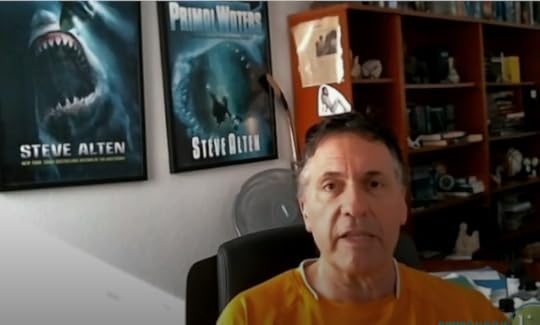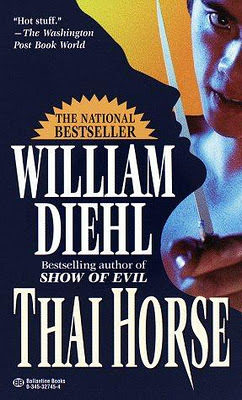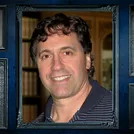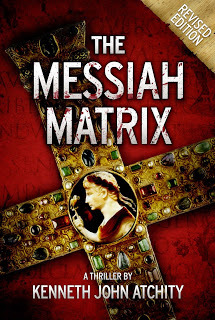Kenneth Atchity's Blog, page 34
May 10, 2023
THE MEG Author, Steve Alten Interviewed KATU
Watch Interview Here

Megalodon- the word literally means "big teeth! Lucky for us these prehistoric 70 foot shards went extinct over 2 million years ago- or did they? Steve Alten explores this possibility in his bestselling book series, "The Meg" which has also been made into 2 movies. He joined us to give us an inside look down deep in the depths of the ocean. For more information about Steve, visit his website here.

May 8, 2023
MEG 2: THE TRENCH - OFFICIAL TRAILER
Get ready for the ultimate adrenaline rush this summer in “Meg 2: The Trench,” a literally larger-than-life thrill ride.
Dive into uncharted waters with Jason Statham and global action icon Wu Jing as they lead a daring research team on an exploratory dive into the deepest depths of the ocean. Their voyage spirals into chaos when a malevolent mining operation threatens their mission and forces them into a high-stakes battle for survival. Pitted against colossal Megs and relentless environmental plunderers, our heroes must outrun, outsmart, and outswim their merciless predators in a pulse-pounding race against time. Immerse yourself in the most electrifying cinematic experience of the year with “Meg 2: The Trench” – where the depths of the ocean are matched only by the heights of sheer, unstoppable excitement!
Warner Bros. Pictures and CMC Pictures present “Meg 2: The Trench,” with Statham and Jing headlining an ensemble cast that also includes Sophia Cai (“The Meg”), Page Kennedy (“The Meg”), Sergio Peris-Mencheta (“Rambo: Last Blood”), Skyler Samuels (“The Gifted”), and Cliff Curtis (“Avatar” franchise).
“Meg 2: The Trench” is directed by Ben Wheatley (“In the Earth,” “Free Fire”), from a screenplay by Jon Hoeber & Erich Hoeber (“The Meg,” “Transformers: Rise of the Beasts”) and Dean Georgaris (“The Meg,” “Lara Croft: Toom Raider – The Cradle of Life”), and a screen story by Dean Georgaris and Jon Hoeber & Erich Hoeber, based on the novel The Trench by Steve Alten.
The film is produced by Lorenzo di Bonaventura and Belle Avery, and executive produced by Jason Statham, Cate Adams, Ruigang Li, Catherine Xujun Ying, Wu Jing, E. Bennett Walsh, Erik Howsam, Gerald R. Molen and Randy Greenberg. Associate Producers Ken Atchity and Chi-Li Wong.
Warner Bros. Pictures and CMC Pictures present, in association with DF Pictures, a di Bonaventura/Apelles Entertainment, Inc. production, a Ben Wheatley film, “Meg 2: The Trench.” It will be distributed worldwide by Warner Bros. Pictures and is set to open in theaters in North America on August 4, 2023 and internationally beginning 02 August 2023.
Meg 2: The Trench’ Motion Poster Promises Trailer Later Today!
Take a bite out of the motion poster below!
Meg 2: The Trench will be swimming into theaters on August 4, 2023.
Get ready for the ultimate adrenaline rush this summer in Meg 2: The Trench, a literally larger-than-life thrill ride that supersizes the 2018 blockbuster and takes the action to higher heights and even greater depths with multiple massive Megs and so much more!
Meg 2: The Trench is directed by Ben Wheatley (In the Earth, Free Fire), from a screenplay by Jon Hoeber & Erich Hoeber (The Meg, Transformers: Rise of the Beasts) and Dean Georgaris (The Meg, Lara Croft: Toom Raider – The Cradle of Life), and a screen story by Dean Georgaris and Jon Hoeber & Erich Hoeber, based on the novel The Trench by Steve Alten.
The film is produced by Lorenzo di Bonaventuraand Belle Avery and executive produced by Jason Statham, Cate Adams, Ruigang Li, Catherine Xujun Ying, Wu Jing, E. Bennett Walsh, Erik Howsam, Gerald R. Molen and Randy Greenberg. Associate Producers Ken Atchity and Chi-LiWong.
via Bloody Disgusting
#FREE May 8 - May 12! William Diehl’s “Thai Horse” - COMING TO THE SCREEN SOON!

Christian Hatcher, the licensed killer they call the Shadow Warrior, is free from a hellhole South American jail. The former special ops officer returns to Hong Kong and Bangkok--- deadly and seductive stops on the heroin pipeline—to track down his best friend, missing since the war.
"Diehl knows how to tell a story, and his novel moves."
-- The New York Times Book Review
"In the best thriller tradition.,"
-- Los Angeles Times
May 3, 2023
Steve Alten will be on Coast 2 Coast with George Noory

LISTEN TO INTERVIEW
 Steve Alten is the best-selling author of fifteen novels, including the MEG series and the DOMAIN series, about the Mayan doomsday calendar. In the first half, he discussed his writing career, cryptozoological creatures like the Loch Ness monster, and his battle with cancer and Parkinson's disease along with new protocols to treat them. His MEG series of novels (now available as the seven-volume collector's edition, Legacy) explores the idea that a monstrous prehistoric shark, the megalodon, still swims deep in the Mariana Trench. In 2018, the motion picture The MEG opened in theaters and became a #1 blockbuster at the box office, both foreign and domestic, grossing over $560 million, though it was a long journey to get it to the screen. The sequel MEG-2: The TRENCH opens in theaters this summer on August 4.
Steve Alten is the best-selling author of fifteen novels, including the MEG series and the DOMAIN series, about the Mayan doomsday calendar. In the first half, he discussed his writing career, cryptozoological creatures like the Loch Ness monster, and his battle with cancer and Parkinson's disease along with new protocols to treat them. His MEG series of novels (now available as the seven-volume collector's edition, Legacy) explores the idea that a monstrous prehistoric shark, the megalodon, still swims deep in the Mariana Trench. In 2018, the motion picture The MEG opened in theaters and became a #1 blockbuster at the box office, both foreign and domestic, grossing over $560 million, though it was a long journey to get it to the screen. The sequel MEG-2: The TRENCH opens in theaters this summer on August 4.

Alten, who has also written novels about the Loch Ness monster, has postulated that the creature is actually a giant eel, some 35 to 45 feet across, which migrated across the Atlantic Ocean from the Sargasso Sea but became trapped in the Loch and continued to grow in size. Alten also addressed his long-term medical struggles and said that certain natural herbal extracts can be helpful for combating tremors from Parkinson's. Regarding cancer, he is a strong advocate for the GC Protocol, developed by Dr. John Grinstein, a biochemist whose area of expertise has focused on the medicinal properties found in certain organic fruits and vegetables.
May 1, 2023
‘The Meg 2: The Trench’ Shows Off Jason Statham, Wu Jing And More Prehistoric Monsters
Jason Statham makes a water jump on a jetski while armed with a sword to fight a shark. So, yeah… that kind of movie.

“The Meg 2: The Trench” is one of the more under-the-radar tentpoles this summer, even though it may end up being one of the biggest global grossers. Why is that?
Well, “The Meg” earned $155 million in North America and $155 million in China toward a $530 million global total. That cume was bigger than any giant monster movie save for “Kong: Skull Island” ($569 million in 2017) and the various “Jurassic” movies. It was the first and thus-far only big-budget Hollywood/Chinese co-production that qualified as a success on both shores. And now “The Meg 2” will try and repeat that performance.
“They’re back for seconds,” the trailer eventually declares, echoing the tongue-in-cheek tone of the first film’s marketing campaign. The trailer opens with two land-bound prehistoric monsters eating a large bug, with onscreen text warning that for 65 million years one species ruled the world. The T-rex? No, the Meg which eats a T-rex (in what was the prologue of the first novel which didn’t make it into the first movie). Jason Statham is recruited again by Cliff Curtis to hunt another giant creature in the trench.
But then, deep underwater, the team starts getting picked off by the biggest meg anyone has ever seen. We then get various monsters attacking by land and by sea, with Statham almost getting eaten by a shark. We get more scenes of tourists almost getting eaten, and a tentacled creature grabbing and devouring a helicopter. The teaser ends with Statham leaping into the air on a jetski to face off against a shark with a sword.
While the franchise could be a case of “folks were just curious the first time,” it is based on Steve Allen’s long-running (eight novels between 1997 and 2022) and popular airport/beach read series about various prehistoric underwater killing machines. There is a fanbase beyond the core hook of Jason Statham fighting a giant shark in and around China.
However, this new installment, with director Ben Wheatley subbing in for Jon Turteltaub, pairs Statham with Wu Jing, who is quite possibly China’s biggest movie star.
If any Hollywood flick is going to thrive in China despite years of comparatively declining grosses, it’ll be “The Meg 2” which pairs Statham with the star of “Wolf Warrior II” ($754 million in 2017), “The Wandering Earth” ($700 million in 2019), “The Battle at Lake Changjin” ($912 million in 2021), “The Battle at Lake Changjin 2” ($626 million in 2022) and “Wandering Earth 2” ($604 million in 2023).
A pre-COVID normal box office performance for “The Meg,” think around $150 million, will be $150 million that most Hollywood releases won’t have this summer. Or, pardon the hyperbole, if “The Meg 2” plays like a local Chinese blockbuster, it may end up flirting with the worldwide totals of Hollywood’s biggest summer movie releases no matter how well it performs elsewhere.
April 28, 2023
“Meg” and “The Meg 2: The Trench” : Exclusive Interview with “Meg” Series Author Steve Alten
Steven Robert Alten (born August 21, 1959, Philadelphia, Pennsylvania) is an American science-fiction author. He is best known for his Meg series of novels set around the fictitious survival of the megalodon, a giant, prehistoric shark. Alten holds a bachelor’s degree from the Pennsylvania State University, a master’s in sports medicine from the University of Delaware, and a doctorate in sports administration from Temple University. Alten is the founder and director of Adopt-An-Author, a nationwide secondary-school free-reading program promoting works from six authors, including his own.

Exclusive Interview with Author Steve Alten
Q: Megalodon is actually creature that now an extinct species of shark that lived from about 23million to 3.6 million years ago during the early Miocene to Pliocene period. What led you to study the megalodon and study shark history as well?
S.A : How did I get started with megalodon? When I was 15 years old I read “Jaws,” as a lot of teens did and really became curious about the great white sharks. I started going to the library, picking up every book I could find about real great white shark attacks. There was always a little blurb listed about its prehistoric cousin — the megalodon. Usually there was a black and white photo of six scientists sitting in a jaw.
But nothing was ever written about it that you could follow up with. When I was 35 years old, I got a magazine in the mail — it’s right here as a matter of fact — Time Magazine, and it talked about the deep and new findings about hydrothermal vents and the Mariana Trench, which is this 1500 mile long, a 40 mile wide gorge at the bottom of the North Pacific Ocean, running in the Western Pacific Ocean. And it’s largely unexplored. I thought, what was that shark I used to be so enamored with back in high school? I went to the library because we had no internet in 1995. I found the picture and information about it. I spent the next 30 days basically creating a treatment for a new book.
Q: Do you know how the megalodon became extinct? What was the reason for that — the weather or lack of food?
S.A: That’s a great question because these weren’t dinosaurs that died off 65 million years ago when an asteroid struck the planet. These were creatures that were around the miocene period which is about 30 million years ago up until fairly recently. It remains a mystery why these apex predators would have died off. There was plenty of food, plenty of whales for them to eat. The great whites were not a threat.
One threat that was there were orca packs which could take out a single megalodon. But the megalodon simply had to go deep to avoid orcas which can only descend to about a thousand feet or even less. So the answer is in that statement — to escape threats on the surface, the megalodons went way deep as in the Mariana Trench. We’ve only explored 5% of our oceans and less than 1% of our deep water. Anything could be down there. We simply have no idea.
Q: The megalodon is considered one of the largest predator fish in history. Their size is mostly known only from fragmentary remains, such as those estimated from their teeth. The appearance and large size is still unknown.
S.A : This is a great white tooth. The tooth measures from the point to the longest root is about an inch and a half. So, they say, there’s about 10 feet of shark for every inch of a tooth. This shark would have been about 15 feet long. Now here’s one from a megalodon.
Q: It’s like four or five times bigger than that.
SA: An inch of tooth equals 10 feet of shark. This is about six to six and a half inches. We’re looking at about a 60- to 70-foot shark here. And the sides. It’s too tiny to see, but these sides are all serrated like a knife. You have the point here. You have the serration. Now, this is a bottom tooth. The difference between a bottom tooth and a top tooth is the thickness of the shape of it. The bottom teeth are more like forks. They’re more pointy. Top teeth are like bludgeons. So it captures it like a fork and then the top tooth comes down and smashes it.
Q: Wow, once a megalodon took a bite out of a whale, it would just take one bite to kill them easily.
S.A : It does a lot of damage.
Q: The megalodon lived all over the world. They spread around the ocean, and were likely to target a small whale, seal or sea turtles and other large animals. I was really surprised that they were eating whales even if it’s a small sized one. It’s a huge animal even if you know the size of whale.
S.A : You have to realize a whale is not a predator. A baleen whale is not a predator. It doesn’t have any defense against a megalodon. The megalodon doesn’t have to eat it in one bite, it just has to wound it to kill it. You can do that by tearing off its pectoral fin, or a bite to its abdomen. Whales are great for a megalodon because it’s very fat and fat is the best kind of energy source in the ocean. It burns easily and lasts a long time. The megalodon has to eat something that’s got enough resources of energy in it and fat is the best source for it to take care of itself.

Q: Let’s talk about the “Meg” movie with Jason Statham. In 1996, before you released your first book of the Meg series, Disney’s Hollywood Pictures bought the rights to the first book. It didn’t work out. What was the reason for that to happen before you released the first book?
S.A: I wrote the original manuscript from 1995 to ’96. Once it was done, I was lucky enough to find a great agent, Ken Atchity of AEI in Los Angeles. Ken thought the idea would make a great movie and book, but it needed a lot of editing. So he brought me on board to edit with him. In May, 1996, I had just about finished the book and he asked me to give him the first hundred pages and a treatment for the rest. He took it to another producer on a first look deal with Disney’s Hollywood Pictures.
The objective was to get a movie deal committed first and then put the book out to other publishers and get a better publishing deal. That’s what we did. But then Hollywood Pictures never made the movie. They had the rights to it but then the president of Hollywood Pictures was fired. When an incoming president comes into a studio, the last thing they want is their predecessor’s projects. If it does well, it makes the other guy look good. It’s all about ego and business.
Q: They didn’t take over the previous project. That’s so hard. It’s so Hollywood.
S.A: They had a nice previous project, but the new studio head wasn’t going to give credit to the other guys. It turned out to be a big hit like it did. So the rights reverted back to me. About six or seven years ago, through a friend, we were able to get optioned by New Line Cinema. They hired their own screenwriter and it turned out to be “Moby Dick” with sharks. It was not the original project and fortunately wasn’t approved so the rights reverted again back to me. We were 0 for 2 at the altar, you might say.
Then I had a friend who had recently met Belle Avery, a producer, and I sold an option for her to make “Meg.” She spent the next six or seven years independently raising the financing for the movie so that the studio wouldn’t have control over what the script was. In the end, she was able to get a Chinese company called Gravity Pictures to put up the money and co-produced it with her. Then they brought in the studio for distribution.
Q: When they had it with New Line Cinema, I believe that Guillermo Del Toro was producing and Jan De Bont from “Speed” was about to direct the film. That was with the New Line Cinema. if the script was OK, it would go along with your intention for your script. It would have worked out fine then. But, the script wasn’t great. Luckily, you got it made with the Chinese. The budget was close to 100 million, right?
S.A: I’m not sure what the final version was. I’m just guessing, but it might have been about 150 or more. I have no way of knowing for sure. Once Warner Brothers came in as a partner, not just for distribution, they bought into the package too.
Q: But since it took almost 20 years to make an original Meg movie, how much did…
S.A: 23, but who’s counting. If I did, I’d be an old man.
Q: How much were you involved in the original film? Did you get involved in the casting process? It had like three screenwriters. What did you discuss with director John Turtletaub?
S.A: The original script that was sold as the project was mine along with Belle Avery. We co-wrote it. But once they brought in the screenwriters, that was it for me. and which is the normal process but I really like the script we wrote. Their screenwriters did a great job too and whether they keep me involved or not… Basically I’m allowed to park the cars [chuckles]. I’m not allowed to do anything. They keep me over on my island and they’re all the way on the other side.

Q: They respect you, the book, and the essence coming from your idea. What do you think of the choice of casting Jason Statham on this one? There are lots of action actors in Hollywood. Was he close to your first choice? Did it surprise you after they cast him and you saw his performance?
S.A: He was my first choice. I loved it when they picked him.Even his first name was similar to the hero’s initials, Jonas as in Jonas Taylor. So I just thought it was meant to be and it was great.
Q: He’s coming back for the second one as well. They had such success. They’re bringing back Statham, but the rest of the cast is different from the original film. They’ve even chosen a different director, Ben Wheatley, known for making great indie films. What do you think about their choice of cast and director this time?
S. A: I haven’t read the script, so it would be unfair for me to give a compliment or begrudge it. I want to go see it with everybody else. Then you can ask me. I’m sure I’ll give a positive answer because I’m sure it’s going to be a great movie. The one thing with the movies and the books, though, is that people don’t realize like with “Jaws,” there was Peter Benchley’s original book, and then there was a “Jaws 2” that somebody had been hired to put together and that was it.
The movies continued on with “Jaws 3D,” “Jaws 4” and whatever mess that followed. They all were half as good as the previous movie. The first movie by Spielberg was terrific. Then each generation lost something in the next movie. The books actually get better than the next one.
As source material, there’ll be a total of seven books packaged together in a seven book set called “The Meg Legacy,” which I’m really excited about. Not only are all seven books in the seven volumes, but the novellas that I wrote, the special projects, and the comic books that made up the graphic stories — everything possibly Meg is in the seven book set. I want to see what’s coming up and read the entire series. That’s the best way to do it and it’s sold on my website: SteveAlten.com.
Q: Your seven-volume collectors edition of the entire Meg series is coming out. You have extra contents in there, all packaged together.
S.A: Everything about the last 25 years of the Meg series, since it was published years ago is in the seven volumes. You’re not just reading the major novel of each volume. You’re also getting the back stories, the behind-the-scenes, the novellas that connect the next two novels. There were gaps in between the novels. I wrote the first book and then four years passed for the second in the series. Four years went by in the storyline.
Then it leaps forward 18 years. So there’s two big gaps there that I wanted to fill, to go back to later. I wrote short stories to fill those gaps. Then when the seven book series was designed, we laid everything out so that it was as if you were to watch a series in its original format, but one after the other after the other. As far as the timeline is concerned, it’s much better reading because it fills in all the gaps while you’re sitting there reading it for the first time.
Q: That’s a great way to tell the story. There’s a prequel in there as well?
S.A: There’s the prequel and that’s another thing. One of the things that’s going on and a major change is the 25th anniversary edition of “Meg,” the first book, which is only in the legacy seven book series. It occupies most of the first volume but it’s brand new because I took the prequel and worked it into the first book so that it all appears at once through flashbacks, through something that is a bit more interesting than just reading a standalone prequel.
Q: Right. That’s a great idea to tell the story all together. It’s amazing. What do you want your reader to take away from your wonderful book series?
S.A: What do I want my readers to take away? Yeah well it’s a good question because the seventh book in this series and the last one is Meg Purgatory. But it leads to something that the readers are going to be shocked at a surprise ending that they had no idea was coming for them. And in Meg Legacy, in the seventh book.. I’m going to expand upon the book and put that special treat in there so that you can only get it through reading.
But as far as the, you know, I really created the Meg Legacy series, the seven books, because for the last 25 years, readers have been contacting me and saying, where can we get the original hardbacks that have the entire collection? And you can’t really because they’re all out of print or the fact that three different publishers handle the printing. you know they don’t work together very well.
Right, I see. So by taking it upon myself through our own publishing company and putting it out there as a collector’s edition with faux leather, hardbacks, you know everything, the deluxe version of everything, pages in gold or silver trim, and not having to worry about the page camp like a lot of publishers do so I can load up on things like the best graphic artists, best images, the best maps, the best… Everything that put the series together the way I wanted it to, full of visual things, it’s all in there, plus authors commentary on different pages. So they have an idea of what was going through my head when I created this. So everything you could possibly think it was in the series.

April 26, 2023
CinemaCon 2023 Unveils Meg 2: The Trench Trailer
Journalist Jeff Sneider tweets, “WB should just rename THE MEG 2 to THE HIT, because that’s what it’s gonna be. She’s hungry and back for seconds! Creatures have escaped an untouched, underwater ecosystem and are wreaking havoc in our world. Trailer is set to Barracuda.”

Meg 2: The Trench
Director: Ben Wheatley
Release Date: August 4, 2023
Exclusive Footage Description: Warner Bros. debuted the trailer for Meg 2: The Trench at CinemaCon 2023. Directed by Ben Wheatley (Free Fire, In the Earth), this sequel is not doubling but tripling down on its absurdity. The footage begins in prehistoric times, where we see a massive T-Rex hunt for fish at a beach only to then be chomped in two by an even bigger megalodon. Fast forward to the present, and the team from the first film led by Jason Statham travels to the bottom of the ocean to make a horrifying discovery: there’s a trench that acts as a doorway to a slew of prehistoric creatures that have survived extinction all these millions of years.
This trench soon releases giant squids, megalodons, and a variety of other prehistoric reptiles upon modern society. More specifically, Jason Statham and his team have to face the main threat of 3 megalodons who hunt together in a pack and are led by the biggest one they have ever seen. The film’s supporting cast, including Sienna Guillory, Cliff Curtis, Shuya Sophia Cai, Page Kennedy, Skyler Samuels, Sergio Peris-Mencheta, and Wu Jing, are all seen getting in on the monster action in the trailer. Statham, though, gets the most batshit insane heroic moments as he rides giant tsunami-sized waves and takes on megalodons on a jet ski one on one with only a huge metallic spear as his weapon.
As previously mentioned, the tone of Meg 2: The Trench has been hyped up to hilarious levels of campiness. Innocent but dumb human bystanders are getting chomped up by megalodons and torn apart by giant squids left and right. The film is leaning heavier into sci-fi as well, with underwater mech suits being utilized in the trench scenes. This looks like a hilarious cross between Jurassic Park and Piranha, which should be music to the ears of genre fans. There’s a taste of over-the-top Fast and Furious levels of action too seeing Jason Statham try to kill megalodons all by himself. One thing’s for sure, Meg 2: The Trench feels like a necessary upgrade in tone and style from the first film.
April 21, 2023
Stealing Time for Your Dream - Part 2: What is Time?

What is time?
Unlike oxygen, an element which is objectively, scientifically definable, and more or less beyond our control, time is relative to perception and subject to choice. “Time,” Melville wrote, “began with man.” The Thrillionaire’s Type C Personality learns to redefine time subjectively, in order to become successful by his own standards. Objective time, dictated by Greenwich Mean Time with an occasional correction for NASA, leads only to the conformity of repetition. Subjective time alone allows us to distinguish ourselves and to achieve our dreams of success.
Logos vs. Mythos
According to the classical Greeks, the two primary ways of perceiving the world were known to them as logos (for the Accountant’s logic) and mythos (for your onboard Visionary’s simultaneity). The Visionary’s belief in eternity in every moment is what makes the Thrillionaire’s life change from barely bearable to ever enthusiastic. “To himself,” Samuel Butler wrote, “everyone is immortal. He may know he is going to die, but he can never know that he is dead.” The Visionary’s eternity is the experience of mythic time that occurs when you “lose yourself” in the pursuit of your dream. Its Brer Rabbit’s “briar patch” speech: “Throw me anywhere, but please don’t throw me in the briar patch!” The briar patch, of course, is Rabbit’s favorite place, his home.
Sometimes you’ll meet an old schoolmate after years and have the experience that “it seems just like yesterday” that you were having this exact same argument, or laughing for the same reason known only to the two of you. A moment passes, as the Accountant wrests control from the Visionary: “But, on the other hand, it seems every bit like the twenty years it’s actually been.” Has it been twenty years, or was it just yesterday? Faulkner said: “There is no such thing as was; if was existed there would be no grief or sorrow.” To the Visionary, time exists always in the present.
Accountant’s time
To the Accountant, who’s kept track of the years--and also the months, weeks, days, hours, minutes, and seconds--precisely, it’s been exactly twenty years, and he can prove it by reciting all the things that have happened to both of you in the interim. The Accountant clocks time with digital precision, obsessive checks with the Internet’s time services. The Accountant’s time is what keeps society sane, if you call today’s society sane.
But when the Accountant’s insistence dominates, you are denied making your dreams come true. The Accountant, nervous about anything intangible or “unseen,” doesn’t believe in dreams; or, at best, assumes the worst about them: “They¹re only dreams.” Human beings can’t fly.
Visionary time
To the Visionary, whose relationship with that same friend is/was intense, it’s just yesterday. The Visionary clocks time only by reference to intensity. Lovers live from embrace to embrace, the time that’s passed between them not counting. Have you ever felt like life would pass you by when you’re stuck in an endless left-turn lane during rush hour? How long does a second last if you’re perched at the parachute door of a plane at 15,000 feet about to make your first jump? How long is forty seconds during a 6.6 earthquake? Or at the edge of a cliff, about to rappel for the first time? A friend of mine described an encounter with a problem customer, “I spent an eternity with her for an hour and a half yesterday.”
The Visionary brings you mythic time when you engage in your Thrillionaire’s dream with all your heart, mind, and soul; when you are occupied in doing something that "takes you out of time," or "takes you out of yourself." You're literally ecstatic--which, from its Greek origins, means "standing outside" yourself. "I don't know where the time went," is what you say when you've just passed fourteen hours creating the whole magical kingdom of Timbuktu on your drawing board--and your spouse, sent by the worried Accountant to tell you you've missed an important dinner party, is banging on the door because you've taken the phone off the hook.
Like Alice's White Rabbit, the Accountant would always have you believe that you’re late for a very important date. And the Accountant doesn’t like it one bit when your Mind’s Eye stops to question how important that date may be; or, whether you made the date in the first place or whether it was made for you. Thrillionaires insist on making their own dates because their Mind’s Eyes (the Mind’s Eye being that part of your mind that’s aware of the conflict between the onboard Accountant and the onboard Visionary) have learned how to insure that mythic time gets preference over logical time.
You’ve had this experience: You’ve told yourself you’re just going to steal "two hours" to work on your dream. You go into the briar patch. One hour and fifty-five minutes have gone by, during which you've been lost--fully engrossed in your quest, without a thought for the outside world that operates on the Greenwich clock. The hours have passed "like a minute" (the Visionary’s way of talking makes the Accountant crazy). Then, you look up at the clock to discover that only five minutes remain of your bargained for two hours. How did you know to look up at the five-minute mark? Because your Accountant never sleeps, even when he’s been taken off duty. If you decide to remain in the mythic time of your dream work beyond the five minutes remaining--that is, beyond the exactly two hours you set aside--the Visionary has won this particular encounter. The Accountant has lost. If you decide to quit "on time," you may think the Accountant has won, and the Visionary lost.
What’s wrong with this win-lose scenario is that it’s exhausting, and impossible to maintain in the long run. Most people, faced with this constant natural strife between the two aspects of their minds, have allowed the Accountant to take over entirely as the only peaceful alternative. They’ve chosen the Accountant’s conservative, safe way of behaving because the daily battle is too costly in energy and emotion. If the Visionary "wins" the five-minute battle, for example, and you continue working on your new invention for another four hours instead of the two you’d set aside, guess how hard it’s going to be for the Accountant to agree to the next two hours you want to steal. The Accountant will use every instrument in the arsenal of procrastination to postpone the trip to your Thrillionaire’s workshop.
How to avoid losing time
Francesco Petrarch: It is appointed for us to lose the present in the expectation of the future.
Petrarch, the first "Renaissance man" and precursor of Eckhart Tolle, was aware that we spend a large majority of our time "somewhere else" than in the present moment. Planning for the future, worrying about the past--so much so that by the time you reach middle age the two horses, Past and Future, are engaged in a life-and-death race along your internal timeline. Competing for your vitality, stealing your present. The time you spend on past responsibilities, past regrets, past relationships, eats into the time available for growth and progress toward your future goals.
If we don't recognize "what’s going on here," as Accountant time and Visionary time battle in our perceptions, we can get very confused. When we get confused, the Accountant can take control of our lives. For most people, the Accountant has been in full control. Consequently, they are frustrated, bored, caught in a rut. With the help of Mercury’s powerful wand--whose two snakes represent the taming of past and future around the strength of present awareness--the entrepreneur’s now-open Mind’s Eye can transform the bloody battlefield into the altar of your hopes and dreams. Awakening his Mind’s Eye, Jack London said:
I shall not waste my days in trying to prolong them. I shall use my time.
This anti-Accountant declaration is made by your Mind’s Eye--which knows that only by marrying the Accountant’s logic with the Visionary’s myth will the present be captured for effective dream work, in lieu of the Visionary wasting the present in daydreaming, or the Accountant in obsessing about the past and the future. When your Mind’s Eye takes charge of these constant time wars, productivity combines with peace of mind. The photographer Ansel Adams said, "I’m amazed at how many people have emotional difficulties. I have none. If you keep busy, you have no time for them."
Next: Work-management doesn’t work
April 17, 2023
Kenneth Atchity's Suspense Thriller The Messiah Matrix FREE April 17 - 21!

AVAILABLE ON AMAZON



